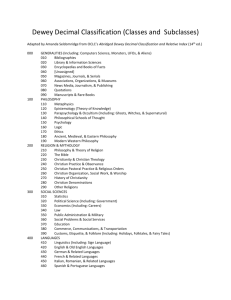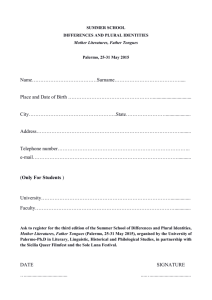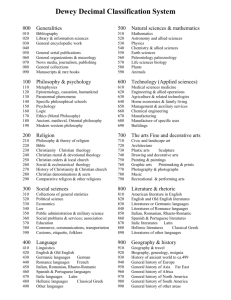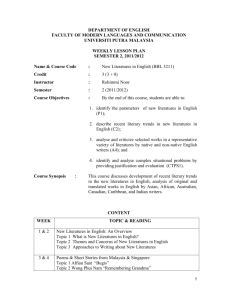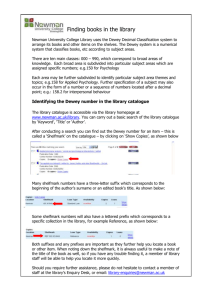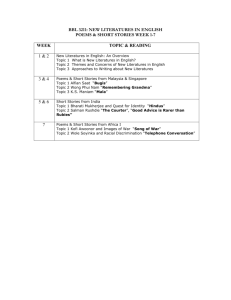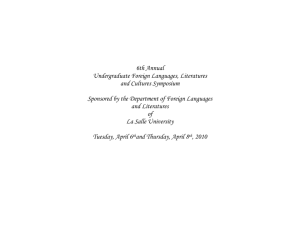Volumes 1 and 2 Guide to Literary Categories American
advertisement
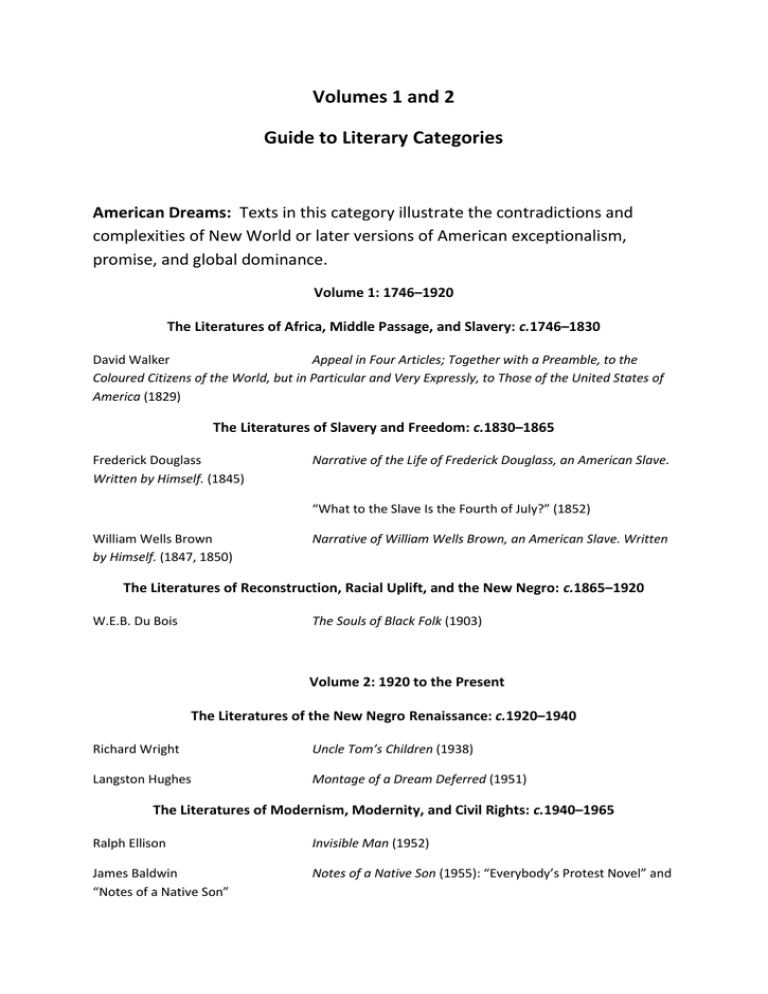
Volumes 1 and 2 Guide to Literary Categories American Dreams: Texts in this category illustrate the contradictions and complexities of New World or later versions of American exceptionalism, promise, and global dominance. Volume 1: 1746–1920 The Literatures of Africa, Middle Passage, and Slavery: c.1746–1830 David Walker Appeal in Four Articles; Together with a Preamble, to the Coloured Citizens of the World, but in Particular and Very Expressly, to Those of the United States of America (1829) The Literatures of Slavery and Freedom: c.1830–1865 Frederick Douglass Written by Himself. (1845) Narrative of the Life of Frederick Douglass, an American Slave. “What to the Slave Is the Fourth of July?” (1852) William Wells Brown by Himself. (1847, 1850) Narrative of William Wells Brown, an American Slave. Written The Literatures of Reconstruction, Racial Uplift, and the New Negro: c.1865–1920 W.E.B. Du Bois The Souls of Black Folk (1903) Volume 2: 1920 to the Present The Literatures of the New Negro Renaissance: c.1920–1940 Richard Wright Uncle Tom’s Children (1938) Langston Hughes Montage of a Dream Deferred (1951) The Literatures of Modernism, Modernity, and Civil Rights: c.1940–1965 Ralph Ellison Invisible Man (1952) James Baldwin “Notes of a Native Son” Notes of a Native Son (1955): “Everybody’s Protest Novel” and Lorraine Hansberry “Willie Loman, Walter Younger, and He Who Must Live” (1959) The Literatures of Nationalism, Militancy, and the Black Aesthetic: c.1965–1975 Amiri Baraka/LeRoi Jones Home: Social Essays (1965) June Jordan On Call: Political Essays (1985) The Literatures of the Contemporary Period: c.1975 to the Present August Wilson Fences (1983) Suzan Lori-Parks The America Play and Other Works (1995) Black Nationalism: Texts in this category describe African American cultural and political consciousness independent of European dominance, influence, and/or control. Nationalism concerned the actual creation of an Africandescended nation state, but also the contestation of Eurocentric institutions and systems. Volume 1: 1746–1920 The Literatures of Africa, Middle Passage, and Slavery: c.1746–1830 David Walker Appeal in Four Articles; Together with a Preamble, to the Coloured Citizens of the World, but in Particular and Very Expressly, to Those of the United States of America (1829) The Literatures of Slavery and Freedom: c.1830–1865 Martin Robison Delany The Condition, Elevation, Emigration, and Destiny of the Colored People of the United States (1852) Volume 2: 1920 to the Present The Literatures of Nationalism, Militancy, and the Black Aesthetic: c.1965–1975 Amiri Baraka/LeRoi Jones Larry Neal June Jordan Home: Social Essays (1965) Black Fire (1968) New Days: Poems of Exile and Return (1974) On Call: Political Essays (1985) Bondage: Texts in this category describe New World African or African American physical, economic, psychological, or emotional enslavement, in terms of either legal institutions in American history (such as slavery or de jure Jim Crow segregation) or incarceration by way of social and cultural figuration. Volume 1: 1746–1920 Literatures of Africa, the Middle Passage, and Slavery: c.1746–1830 Briton Hammon Narrative of the Uncommon Sufferings and Surprizing Deliverance of Briton Hammon, a Negro Man (1760) Olaudah Equiano Interesting Narrative of the Life of Olaudah Equiano, or Gustavus Vassa, the African, Written by Himself (1789, 1791) David Walker Appeal in Four Articles; Together with a Preamble, to the Coloured Citizens of the World, but in Particular and Very Expressly, to Those of the United States of America (1829) The Literatures of Slavery and Freedom: c.1830–1865 Omar ibn Said Autobiography of Omar ibn Said, Slave in North Carolina (1831) Frederick Douglass Written by Himself. (1845) Narrative of the Life of Frederick Douglass, an American Slave. William Wells Brown Himself. (1847, 1950) Narrative of William Wells Brown, an American Slave. Written by The Escape; or, a Leap for Freedom: A Drama in Five Acts (1858) Harriet Jacobs Incidents in the Life of a Slave Girl. Written by Herself. (1861) The Literatures of Reconstruction, Racial Uplift, and the New Negro: c.1865–1920 Pauline E. Hopkins Four Acts (1879) Peculiar Sam, or the Underground Railroad: A Musical Drama in Booker T. Washington Up from Slavery (1901) Volume 2: 1920 to the Present The Literatures of the New Negro Renaissance: c.1920–1940 Richard Wright Uncle Tom’s Children (1938): “Big Boy Leaves Home” The Literatures of the Contemporary Period: c.1975 to the Present Octavia Butler Kindred (1979) Ernest Gaines A Lesson Before Dying (1993) Edward P. Jones The Known World (2003) Charles R. Johnson “The End of the Black American Narrative” (2008) The American Civil War and Reconstruction: Texts in this category document and reimagine the causes or consequences of the American Civil War and Reconstruction. Volume 1: 1746–1920 The Literatures of Reconstruction, Racial Uplift, and the New Negro: c.1865–1920 Pauline E. Hopkins Drama in Four Acts (1879) Peculiar Sam, or the Underground Railroad: A Musical Charles Waddell Chesnutt “What is a White Man?” (1889) The Marrow of Tradition (1901) Frances Ellen Watkins Harper Sketches of Southern Life (1891) Iola Leroy, or Shadows Uplifted (1892) Anna Julia Cooper A Voice from the South (1892) Booker T. Washington Up from Slavery (1901) W.E.B. Du Bois The Souls of Black Folk (1903) Education and Literacy: Texts in this category articulate education and literacy as contexts of social uplift, as mechanisms of further acculturating African Americans to American society, but also as modes of cultural and political resistance. Volume 1: 1746–1920 The Literatures of Africa, Middle Passage, and Slavery: c.1746–1830 Jupiter Hammon “An Address to Miss Phillis Wheatly, Ethiopian Poetess, in Boston, Who Came from Africa at Eight Years of Age, and Soon Became Acquainted with the Gospel of Jesus Christ” (1778) David Walker Appeal in Four Articles; Together with a Preamble, to the Coloured Citizens of the World, but in Particular and Very Expressly, to Those of the United States of America (1829) The Literatures of Slavery and Freedom: c.1830–1865 Omar ibn Said Autobiography of Omar ibn Said, Slave in North Carolina (1831) Frederick Douglass Written by Himself. (1845) Narrative of the Life of Frederick Douglass, an American Slave. The Literatures of Reconstruction, Racial Uplift, and the New Negro: c.1865–1920 Frances Ellen Watkins Harper Sketches of Southern Life (1891) Iola Leroy, or Shadows Uplifted (1892) Anna Julia Cooper A Voice from the South (1892) Booker T. Washington Up from Slavery (1901) W.E.B. Du Bois The Souls of Black Folk (1903) Volume 2: 1920 to the Present The Literatures of Modernism, Modernity, and Civil Rights: c.1940–1965 Gwendolyn Brooks A Street in Bronzeville (1945) Ralph Ellison Invisible Man (1952) The Literatures of the Contemporary Period: c.1975 to the Present Harryette Mullen Sleeping with the Dictionary (2002) Feminism and Women’s Rights: Texts in this category reflect the contest in American society over women’s rights from the first wave through the third wave, and include direct challenges to male dominance, sexism, patriarchy, and misogyny. Volume 1: 1746–1920 The Literatures of Slavery and Freedom: c.1830–1865 Harriet Jacobs Incidents in the Life of a Slave Girl. Written by Herself. (1861) The Literatures of Reconstruction, Racial Uplift, and the New Negro: c.1865–1920 Anna Julia Cooper A Voice from the South (1892): “Womanhood: A Vital Element in the Regeneration and Progress of a Race” Volume 2: 1920 to the Present The Literatures of the New Negro Renaissance: c.1920–1940 Helene Johnson [Selected Poems] 1925–1929 The Literatures of Nationalism, Militancy, and the Black Aesthetic: c.1965–1975 Lucille Clifton Good Times (1969) June Jordan Some Changes (1971) Sonia Sanchez A Blues Book for a Blue Black Magic Woman (1974) The Literatures of the Contemporary Period: c.1975 to the Present Ntozake Shange enuf (1975) for colored girls who have considered suicide/when the rainbow is Alice Walker The Color Purple (1982) In Search of Our Mothers’ Gardens (1983) Audre Lorde Sister Outsider (1984) Gender: Texts in this category demonstrate the social and political construction of gender, which was a basis of African American personal and group identity but also a source of conflict within African American political discourse. Volume 1: 1746–1920 The Literatures of Slavery and Freedom: c.1830–1865 Harriet E. Wilson Our Nig; or, Sketches from the Life of a Free Black (1859) Harriet Jacobs Incidents in the Life of a Slave Girl. Written by Herself. (1861) The Literatures of Reconstruction, Racial Uplift, and the New Negro: c.1865–1920 Frances Ellen Watkins Harper Iola Leroy, or Shadows Uplifted (1892) Anna Julia Cooper A Voice from the South (1892) Volume 2: 1920 to the Present The Literatures of the New Negro Renaissance: c.1920–1940 Helene Johnson [Selected Poems] 1925–1929 Nella Larsen Passing (1929) The Literatures of Modernism, Modernity, and Civil Rights: c.1940–1965 Ann Petry “The Bones of Louella Brown” (1947) “In Darkness and Confusion” (1947) Gwendolyn Brooks Annie Allen (1949) The Literatures of Nationalism, Militancy, and the Black Aesthetic: c.1965–1975 Amiri Baraka/LeRoi Jones Dutchman (1964) Larry Neal Black Fire (1968) June Jordan Some Changes (1971) Sonia Sanchez A Blues Book for a Blue Black Magic Woman (1974) The Literatures of the Contemporary Period: c.1975 to the Present Ntozake Shange enuf (1975) for colored girls who have considered suicide/when the rainbow is Audre Lorde The Black Unicorn (1978) Sister Outsider (1984) Alice Walker The Color Purple (1982) Gloria Naylor The Women of Brewster Place (1982) Toni Morrison “Recitatif” (1983) Intertextuality: Texts in this category actively interpret and interrogate historical or contemporaneous texts to reveal or resolve contradictions. Volume 1: 1746–1920 The Literatures of Africa, Middle Passage, and Slavery: c.1746–1830 David Walker Appeal in Four Articles; Together with a Preamble, to the Coloured Citizens of the World, but in Particular and Very Expressly, to Those of the United States of America (1829) The Literatures of Slavery and Freedom: c.1830 - 1865 Harriet E. Wilson Our Nig; or, Sketches from the Life of a Free Black (1859) Harriet Jacobs Incidents in the Life of a Slave Girl. Written by Herself. (1861) The Literatures of Reconstruction, Racial Uplift, and the New Negro: c.1865–1920 Pauline E. Hopkins Four Acts (1879) Peculiar Sam, or the Underground Railroad: A Musical Drama in Volume 2: 1920 to the Present The Literatures of Modernism, Modernity, and Civil Rights: c.1940–1965 James Baldwin “Notes of a Native Son” Notes of a Native Son (1955): “Everybody’s Protest Novel” and Literary Criticism: Texts in this category examine the definition and creation of African American literature as well as this literature’s potential role in racial uplift and politics. Volume 2: 1920 to the Present The Literatures of the New Negro Renaissance: c.1920–1940 W.E.B. Du Bois “The Negro Mind Reaches Out” (1925) “Criteria of Negro Art” (1926) Alain Locke The New Negro (1925): “The New Negro” Langston Hughes “The Negro Artist and the Racial Mountain” (1926) George S. Schuyler “The Negro-Art Hokum” (1926) The Literatures of Modernism, Modernity, and Civil Rights: c.1940–1965 Ralph Ellison Shadow and Act (1964) The Literatures of Nationalism, Militancy, and the Black Aesthetic: c.1965–1975 Larry Neal Black Fire (1968): “And Shine Swam On” The Literatures of the Contemporary Period: c.1975 to the Present Alice Walker In Search of Our Mothers’ Gardens (1983) Toni Morrison “Recitatif” (1983) Walter Mosley “Black to the Future” (1998) Immigration and Migration: Texts in this category investigate the enforced or voluntary movement of New World Africans or African Americans and its personal, cultural, and political implications. Volume 1: 1746–1920 The Literatures of Africa, Middle Passage, and Slavery: c.1746–1830 Briton Hammon Narrative of the Uncommon Sufferings and Surprizing Deliverance of Briton Hammon, a Negro Man (1760) Olaudah Equiano Interesting Narrative of the Life of Olaudah Equiano, or Gustavus Vassa, the African, Written by Himself (1789, 1791) Volume 2: 1920 to the Present The Literatures of the New Negro Renaissance: c.1920–1940 Rudolph Fisher “The City of Refuge” (1925) The Literatures of Modernism, Modernity, and Civil Rights: c.1940–1965 Gwendolyn Brooks A Street in Bronzeville (1945) Ralph Ellison Invisible Man (1952) The Literatures of the Contemporary Period: c.1975 to the Present Edwidge Danticat Krik? Krak! (1996): “New York Women” Passing: Texts in this category portray the “crossing of the color line” as a selfcentered strategy of securing the privileges of Anglo-American society, as a demonstration of the performance (rather than the biology) of racial identity, and as a complication of the black–white binary into which American race relations are often put. Volume 1: 1746–1920 The Literatures of Reconstruction, Racial Uplift, and the New Negro: c.1865–1920 Charles Waddell Chesnutt “What is a White Man?” (1889) The Marrow of Tradition (1901) Frances Ellen Watkins Harper Iola Leroy, or Shadows Uplifted (1892) James Weldon Johnson The Autobiography of an Ex-Colored Man (1912, 1927) Volume 2: 1920 to the Present The Literatures of the New Negro Renaissance: c.1920–1940 Nella Larsen Passing (1929) George S. Schuyler Black No More; Being an Account of the Strange and Wonderful Workings of Science in the Land of the Free, A. D. 1933–1940 (1931) Protest Literature: In this category, texts are considered protest literature when they directly challenge the political, social, economic, and emotional mistreatment and/or exploitation of African American people. Volume 1: 1746–1920 The Literatures of Africa, Middle Passage, and Slavery: c.1746–1830 Olaudah Equiano Interesting Narrative of the Life of Olaudah Equiano, or Gustavus Vassa, the African, Written by Himself (1789, 1791) David Walker Appeal in Four Articles; Together with a Preamble, to the Coloured Citizens of the World, but in Particular and Very Expressly, to Those of the United States of America (1829) The Literatures of Slavery and Freedom: c.1830–1865 Frederick Douglass “What to the Slave is the Fourth of July?” (1852) Volume 2: 1920 to the Present The Literatures of Modernism, Modernity and Civil Rights: c.1940–1965 James Baldwin “Notes of a Native Son” Notes of a Native Son (1955): “Everybody’s Protest Novel” and The Literatures of Nationalism, Militancy, and the Black Aesthetic: c.1965–1975 Amiri Baraka/LeRoi Jones Home: Social Essays (1965) Larry Neal Black Fire (1968): “And Shine Swam On” June Jordan Some Changes (1971) New Days: Poems of Exile and Return (1974) On Call: Political Essays (1985) Sonia Sanchez A Blues Book for a Blue Black Magic Woman (1974) Race: Texts in this category highlight the cultural and political construction of “race,” and the role that this construct has played in determining social access, privilege, and ostracism across American history. Volume 1: 1746–1920 The Literatures of Africa, Middle Passage, and Slavery: c.1746–1830 David Walker Appeal in Four Articles; Together with a Preamble, to the Coloured Citizens of the World, but in Particular and Very Expressly, to Those of the United States of America (1829) The Literatures of Reconstruction, Racial Uplift, and the New Negro: c.1865–1920 Charles Waddell Chesnutt Anna Julia Cooper Booker T. Washington W.E.B. Du Bois “What Is a White Man?” (1889) A Voice from the South (1892) Up from Slavery (1901) The Souls of Black Folk (1903) James Weldon Johnson The Autobiography of an Ex-Colored Man (1912, 1927) Volume 2: 1920 to the Present The Literatures of the New Negro Renaissance: c.1920–1940 Claude McKay Harlem Shadows (1922) Jessie Fauset “Dark Algiers the White” (1925) Alain Locke The New Negro (1925) Langston Hughes “The Negro Artist and the Racial Mountain” (1926) The Weary Blues (1926) Zora Neale Hurston “How It Feels to Be Colored Me” (1928) Countée Cullen The Black Christ and Other Poems (1929) George S. Schuyler Black No More; Being an Account of the Strange and Wonderful Workings of Science in the Land of the Free, A. D. 1933–1940 (1931) Richard Wright Uncle Tom’s Children (1938): “Big Boy Leaves Home” “How ‘Bigger’ Was Born” (1940) The Literatures of Modernism, Modernity, and Civil Rights: c.1940–1965 Ann Petry “In Darkness and Confusion” (1947) Ralph Ellison Invisible Man (1952) Lorraine Hansberry “Willie Loman, Walter Younger, and He Who Must Live” (1959) The Literatures of Nationalism, Militancy, and the Black Aesthetic: c.1965–1975 Amiri Baraka/LeRoi Jones Dutchman (1964) Adrienne Kennedy Funnyhouse of a Negro (1964) Larry Neal Black Fire (1968) Michael S. Harper Dear John, Dear Coltrane (1970) The Literatures of the Contemporary Period: c.1975 to the Present Ntozake Shange enuf (1975) for colored girls who have considered suicide/when the rainbow is Toni Morrison “Recitatif” (1983) Suzan Lori-Parks The America Play and Other Works (1995) Walter Mosley “Black to the Future” (1998) Charles R. Johnson “The End of the Black American Narrative” (2008) Racial Uplift:Texts in this category typify the longstanding African American use of literary and cultural expression to promote the progress, elevation, success, and redemption of “the race,” but they also include strategic criticism of this doctrine’s limitations. Volume 1: 1746–1920 The Literatures of Africa, Middle Passage, and Slavery: c.1746–1830 Jupiter Hammon “An Address to Miss Phillis Wheatly, Ethiopian Poetess, in Boston, Who Came from Africa at Eight Years of Age, and Soon Became Acquainted with the Gospel of Jesus Christ” (1778) David Walker Appeal in Four Articles; Together with a Preamble, to the Coloured Citizens of the World, but in Particular and Very Expressly, to Those of the United States of America (1829) The Literatures of Slavery and Freedom: c.1830–1865 Frederick Douglass Written by Himself. (1845) Narrative of the Life of Frederick Douglass, an American Slave. William Wells Brown Himself. (1847, 1950) Narrative of William Wells Brown, an American Slave. Written by The Escape; or, a Leap for Freedom: A Drama in Five Acts (1858) Martin Robison Delany The Condition, Elevation, Emigration, and Destiny of the Colored People of the United States (1852) Harriet E. Wilson Our Nig; or, Sketches from the Life of a Free Black (1859) Harriet Jacobs Incidents in the Life of a Slave Girl. Written by Herself. (1861) The Literatures of Reconstruction, Racial Uplift, and the New Negro: c.1865–1920 Frances Ellen Watkins Harper Iola Leroy, or Shadows Uplifted (1892) Anna Julia Cooper A Voice from the South (1892) Charles Waddell Chesnutt The Marrow of Tradition (1901) Booker T. Washington Up from Slavery (1901) W.E.B. Du Bois The Souls of Black Folk (1903) James Weldon Johnson The Autobiography of an Ex-Colored Man (1912, 1927) Volume 2: 1920 to the Present The Literatures of the New Negro Renaissance: c.1920–1940 W.E.B. Du Bois “The Negro Mind Reaches Out” (1925) “Criteria of Negro Art” (1926) Alain Locke The New Negro (1925) Langston Hughes “The Negro Artist and the Racial Mountain” (1926) George S. Schuyler “The Negro-Art Hokum” (1926) Countée Cullen The Black Christ and Other Poems (1929) Richard Wright “Blueprint for Negro Writing” (1937) The Literatures of the Contemporary Period: c.1975 to the Present Harryette Mullen Sleeping with the Dictionary (2002) Segregation: Texts in this category address the de facto and de jure examples and consequences of enforced separation of blacks from whites in American society. Volume 1: 1746–1920 The Literatures of Africa, Middle Passage, and Slavery: c.1746–1830 David Walker Appeal in Four Articles; Together with a Preamble, to the Coloured Citizens of the World, but in Particular and Very Expressly, to Those of the United States of America (1829) The Literatures of Slavery and Freedom: c.1830–1865 Harriet Wilson Our Nig; or, Sketches from the Life of a Free Black (1859) The Literatures of Reconstruction, Racial Uplift, and the New Negro: c.1865–1920 Charles Waddell Chesnutt The Marrow of Tradition (1901) James Weldon Johnson The Autobiography of an Ex-Colored Man (1912, 1927) Volume 2: 1920 to the Present The Literatures of the New Negro Renaissance: c.1920–1940 Rudolph Fisher “The City of Refuge” (1925) Nella Larsen Passing (1929) George S. Schuyler Black No More; Being an Account of the Strange and Wonderful Workings of Science in the Land of the Free, A. D. 1933–1940 (1931) Richard Wright Uncle Tom’s Children (1938): “Big Boy Leaves Home” The Literatures of Modernism, Modernity, and Civil Rights: c.1940–1965 Langston Hughes Montage of a Dream Deferred (1951) Ralph Ellison Invisible Man (1952) Lorraine Hansberry “Willie Loman, Walter Younger, and He Who Must Live” (1959) The Literatures of Nationalism, Militancy, and the Black Aesthetic: c.1965–1975 Amiri Baraka/LeRoi Jones Home: Social Essays (1965) The Literatures of the Contemporary Period: c.1975 to the Present Ntozake Shange enuf (1975) for colored girls who have considered suicide/when the rainbow is Alice Walker The Color Purple (1982) Rita Dove Thomas and Beulah (1986) Ernest Gaines A Lesson Before Dying (1993) Sexuality: Texts in this category cover the wide range of African American understandings of sexual identity, touching on the sexual anxieties of homophobia, of racial oppression in white male rape of black women, and of exertions of power in personal and political relationships. Volume 1: 1746–1920 The Literatures of Slavery and Freedom: c.1830–1865 Harriet Jacobs Incidents in the Life of a Slave Girl. Written by Herself. (1861) Volume 2: 1920 to the Present The Literatures of Nationalism, Militancy, and the Black Aesthetic: c.1965–1975 Amiri Baraka/Lerroi Jones Dutchman (1964) June Jordan Some Changes (1971) The Literatures of the Contemporary Period: c.1975 to the Present Ntozake Shange rainbow is enuf (1975) for colored girls who have considered suicide/when the Alice Walker The Color Purple (1982) Gloria Naylor The Women of Brewster Place (1982) Audre Lorde Sister Outsider (1984) Captivity and Slave Narratives: Texts in this category, especially those written before the Civil War, attack the institution of American slavery in standard thematic depictions of confrontations between masters and slaves, the harrowing and fortuitous escape of some slaves, and the possibilities of personal and racial redemption. Volume 1: 1746–1920 The Literatures of Africa, Middle Passage, and Slavery: c.1746–1830 Briton Hammon Narrative of the Uncommon Sufferings and Surprizing Deliverance of Briton Hammon, a Negro Man (1760) Olaudah Equiano Interesting Narrative of the Life of Olaudah Equiano, or Gustavus Vassa, the African, Written by Himself (1789, 1791) The Literatures of Slavery and Freedom: c.1830–1865 Frederick Douglass Written by Himself. (1845) Narrative of the Life of Frederick Douglass, an American Slave. William Wells Brown Himself. (1847, 1950) Narrative of William Wells Brown, an American Slave. Written by Harriet Jacobs Incidents in the Life of a Slave Girl. Written by Herself. (1861) The South: Texts in this category focus on the controversies and legacies of the states normally identified in American history with antebellum slavery, Confederate secession, Reconstruction, Jim Crow, lynching, and segregation. Volume 1: 1746–1920 The Literatures of Slavery and Freedom: c.1830–1865 Omar ibn Said Autobiography of Omar ibn Said, Slave in North Carolina (1831) Frederick Douglass Written by Himself. (1845) Narrative of the Life of Frederick Douglass, an American Slave. Harriet Jacobs Incidents in the Life of a Slave Girl. Written by Herself. (1861) The Literatures of Reconstruction, Racial Uplift, and the New Negro: c.1865–1920 Pauline E. Hopkins Four Acts (1879) Peculiar Sam, or the Underground Railroad: A Musical Drama in Frances Ellen Watkins Harper Sketches of Southern Life (1891) Iola Leroy, or Shadows Uplifted (1892) Ann Julia Cooper A Voice from the South (1892) Paul Laurence Dunbar Lyrics of Lowly Life (1896) The Heart of Happy Hollow (1904): “The Lynching of Jube Benson” Charles Waddell Chesnutt The Marrow of Tradition (1901) Booker T. Washington Up from Slavery (1901) Volume 2: 1920 to the Present The Literatures of the New Negro Renaissance: c.1920–1940 Jean Toomer Cane (1923) Balo (1924, 1927) Zora Neale Hurston “The Back Room” (1927) Sterling A. Brown Southern Road (1932) Richard Wright Uncle Tom’s Children (1938) The Literatures of the Contemporary Period: c.1975 to the Present Alice Walker The Color Purple (1982) Rita Dove Thomas and Beulah (1986) Edward P. Jones The Known World (2003) Trauma: Texts in this category explore the psychological and communal devastation resulting from historical and systemic racial prejudice, discrimination, and violence, as well as the dimensions of resistance and recovery thereafter. Volume 1: 1746–1920 Literatures of Africa, Middle Passage, and Slavery: c.1746–1830 Olaudah Equiano Interesting Narrative of the Life of Olaudah Equiano, or Gustavus Vassa, the African, Written by Himself (1789, 1791) The Literatures of Slavery and Freedom: c.1830–1865 Frederick Douglass Written by Himself. (1845) Narrative of the Life of Frederick Douglass, an American Slave. William Wells Brown Himself. (1847, 1950) Narrative of William Wells Brown, an American Slave. Written by The Escape; or, a Leap for Freedom: A Drama in Five Acts (1858) Harriet Jacobs Incidents in the Life of a Slave Girl. Written by Herself. (1861) The Literatures of Reconstruction, Racial Uplift, and the New Negro: c.1865–1920 Charles Waddell Chesnutt The Marrow of Tradition (1901) Paul Laurence Dunbar The Heart of Happy Hollow (1904): “The Lynching of Jube Benson” James Weldon Johnson The Autobiography of an Ex-Colored Man (1912, 1927) Volume 2: 1920 to the Present The Literatures of the New Negro Renaissance: c.1920–1940 Rudolph Fisher “The City of Refuge” (1925) Langston Hughes The Weary Blues (1926) Richard Wright Uncle Tom’s Children (1938): “Big Boy Leaves Home” “How ‘Bigger’ Was Born” (1940) The Literatures of Modernism, Modernity, and Civil Rights: c.1940–1965 Chester Himes “A Night of New Roses” (1945) “Da-Da-Dee” (1948) “Tang” (1967) Ralph Ellison Invisible Man (1952) James Baldwin “Notes of a Native Son” Notes of a Native Son (1955): “Everybody’s Protest Novel” and The Literatures of Nationalism, Militancy, and the Black Aesthetic: c.1965–1975 Amiri Baraka/LeRoi Jones Dutchman (1964) The Literatures of the Contemporary Period: c.1975 to the Present Ntozake Shange enuf (1975) for colored girls who have considered suicide/when the rainbow is Alice Walker The Color Purple (1982) Ernest Gaines A Lesson Before Dying (1993) John Edgar Wideman God's Gym (2005): “Weight” Urban Spaces: Texts in this category navigate the meaning of urban spaces to African Americans who escaped slavery, intimidation and violence, and Jim Crow in the rural South, yet who still grappled with racial inequity and racism, even as these new cityscapes afforded a slate for distinctive expressions of African American culture. Volume 1: 1746–1920 The Literatures of Africa, Middle Passage, and Slavery: c.1746–1830 David Walker Appeal in Four Articles; Together with a Preamble, to the Coloured Citizens of the World, but in Particular and Very Expressly, to Those of the United States of America (1829) The Literatures of Reconstruction, Racial Uplift, and the New Negro: c.1865–1920 James Weldon Johnson The Autobiography of an Ex-Colored Man (1912, 1927) Volume 2: 1920 to the Present The Literatures of the New Negro Renaissance: c.1920–1940 Claude McKay Harlem Shadows (1922) Banjo: A Story without a Plot (1929) Rudolph Fisher “The City of Refuge” (1925) “Blades of Steel” (1927) Langston Hughes The Weary Blues (1926) Montage of a Dream Deferred (1951) Richard Wright “How ‘Bigger’ Was Born” (1940) The Literatures of Modernism, Modernity, and Civil Rights: c.1940–1965 Gwendolyn Brooks A Street in Bronzeville (1945) Ann Petry “In Darkness and Confusion” (1947) James Baldwin “Notes of a Native Son” Notes of a Native Son (1955): “Everybody’s Protest Novel” and Lorraine Hansberry “Willie Loman, Walter Younger, and He Who Must Live” (1959) The Literatures of the Contemporary Period: c.1975 to the Present Gloria Naylor The Women of Brewster Place (1982) Edwidge Danticat Krik? Krak! (1996): “New York Day Women” Violence: Texts in this category document and reimagine the longstanding role violence has played in the social control of African Americans under slavery, segregation, and exploitation. Volume 1: 1746–1920 The Literatures of Africa, Middle Passage, and Slavery: c.1746–1830 Lucy Terry “Bars Fight” (1746/1855) Olaudah Equiano Interesting Narrative of the Life of Olaudah Equiano, or Gustavus Vassa, the African, Written by Himself (1789, 1791) The Literatures of Slavery and Freedom: c.1830–1865 Frederick Douglass Written by Himself. (1845) Narrative of the Life of Frederick Douglass, an American Slave. William Wells Brown Himself. (1847, 1950) Narrative of William Wells Brown, an American Slave. Written by Harriet Wilson Our Nig; or, Sketches from the Life of a Free Black (1859) Harriet Jacobs Incidents in the Life of a Slave Girl. Written by Herself. (1861) The Literatures of Reconstruction, Racial Uplift, and the New Negro: c.1865–1920 Charles Waddell Chesnutt The Marrow of Tradition (1901) W.E.B. Du Bois The Souls of Black Folk (1903) Paul Laurence Dunbar The Heart of Happy Hollow (1904): “The Lynching of Jube Benson” James Weldon Johnson The Autobiography of an Ex-Colored Man (1912, 1927) Volume 2: 1920 to the Present The Literatures of the New Negro Renaissance: c.1920–1940 Rudolph Fisher “The City of Refuge” (1925) Richard Wright Uncle Tom’s Children (1938): “Big Boy Leaves Home” The Literatures of Modernism, Modernity, and Civil Rights: c.1940–1965 Chester Himes “A Night of New Roses” (1945) “Tang” (1967) Ann Petry “In Darkness and Confusion” (1947) Robert Hayden of Nat Turner” Ballad of Remembrance (1962): “Middle Passage” and “The Ballad The Literatures of Nationalism, Militancy, and the Black Aesthetic: c.1965–1975 Amiri Baraka/LeRoi Jones Dutchman (1964) The Literatures of the Contemporary Period: c.1975 to the Present Ntozake Shange enuf (1975) for colored girls who have considered suicide/when the rainbow is Octavia Butler Kindred (1979) Alice Walker The Colored Purple (1982) Ernest Gaines A Lesson Before Dying (1993)

